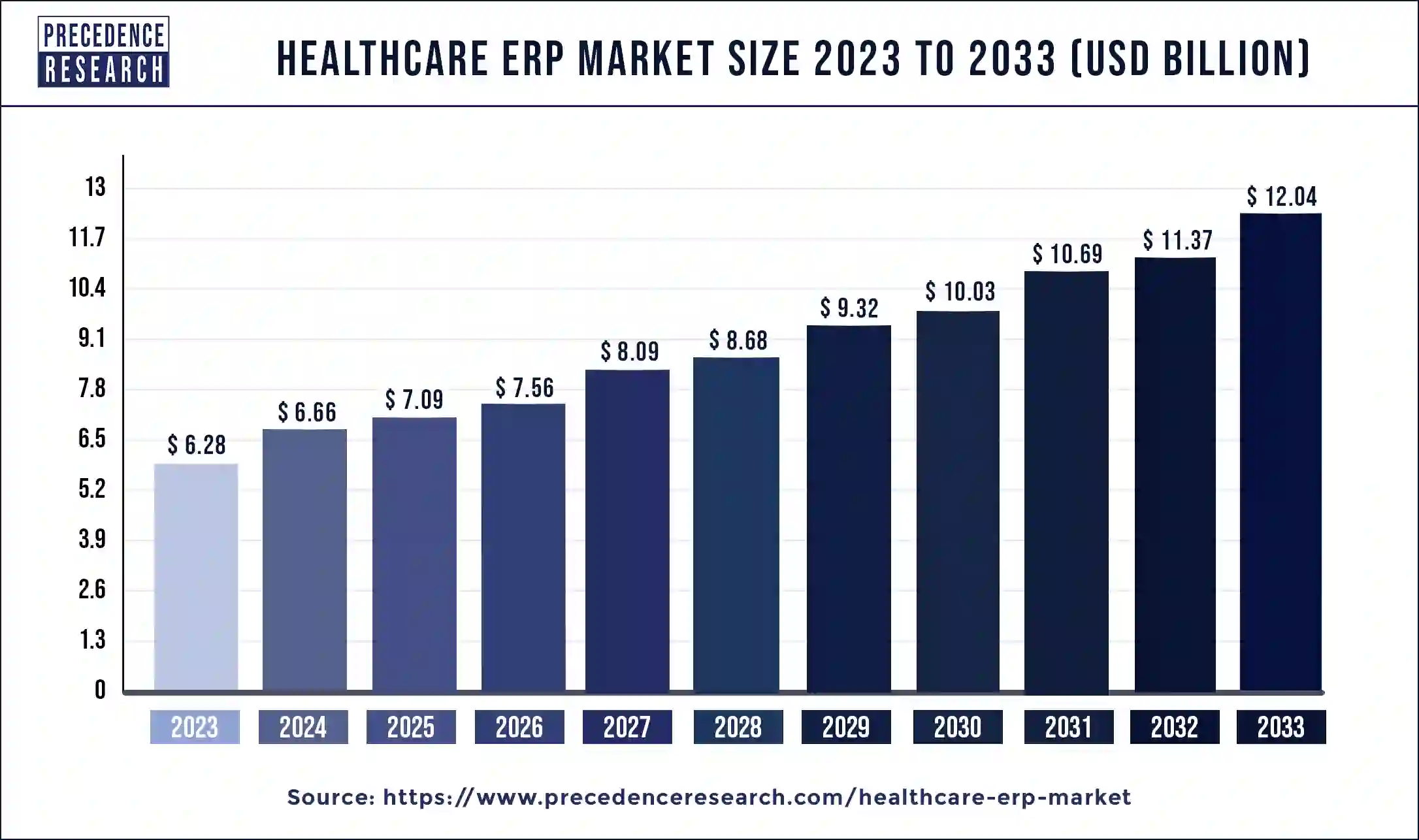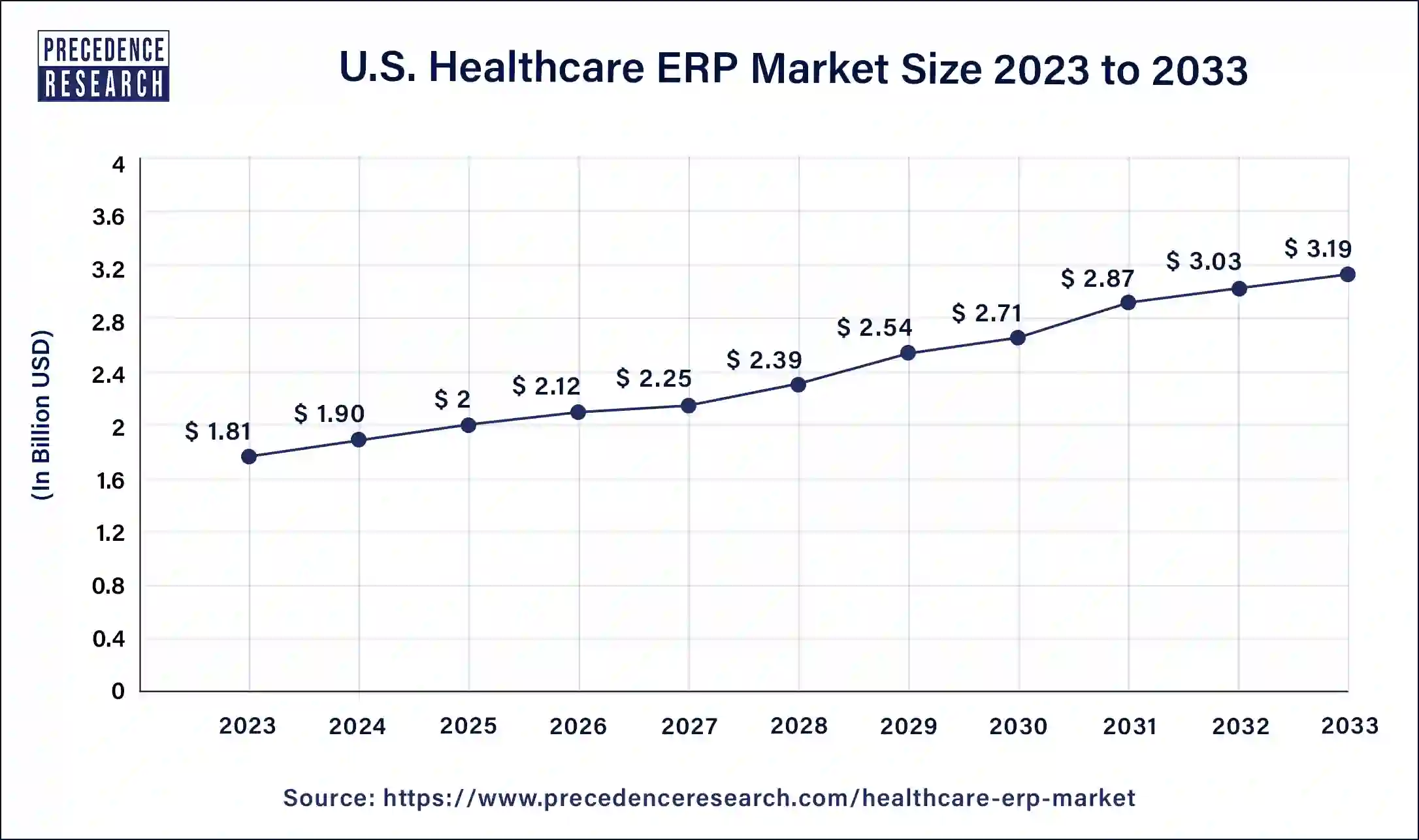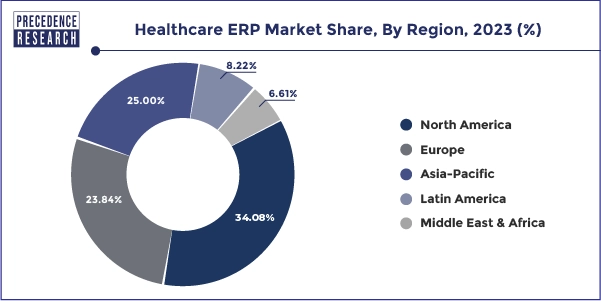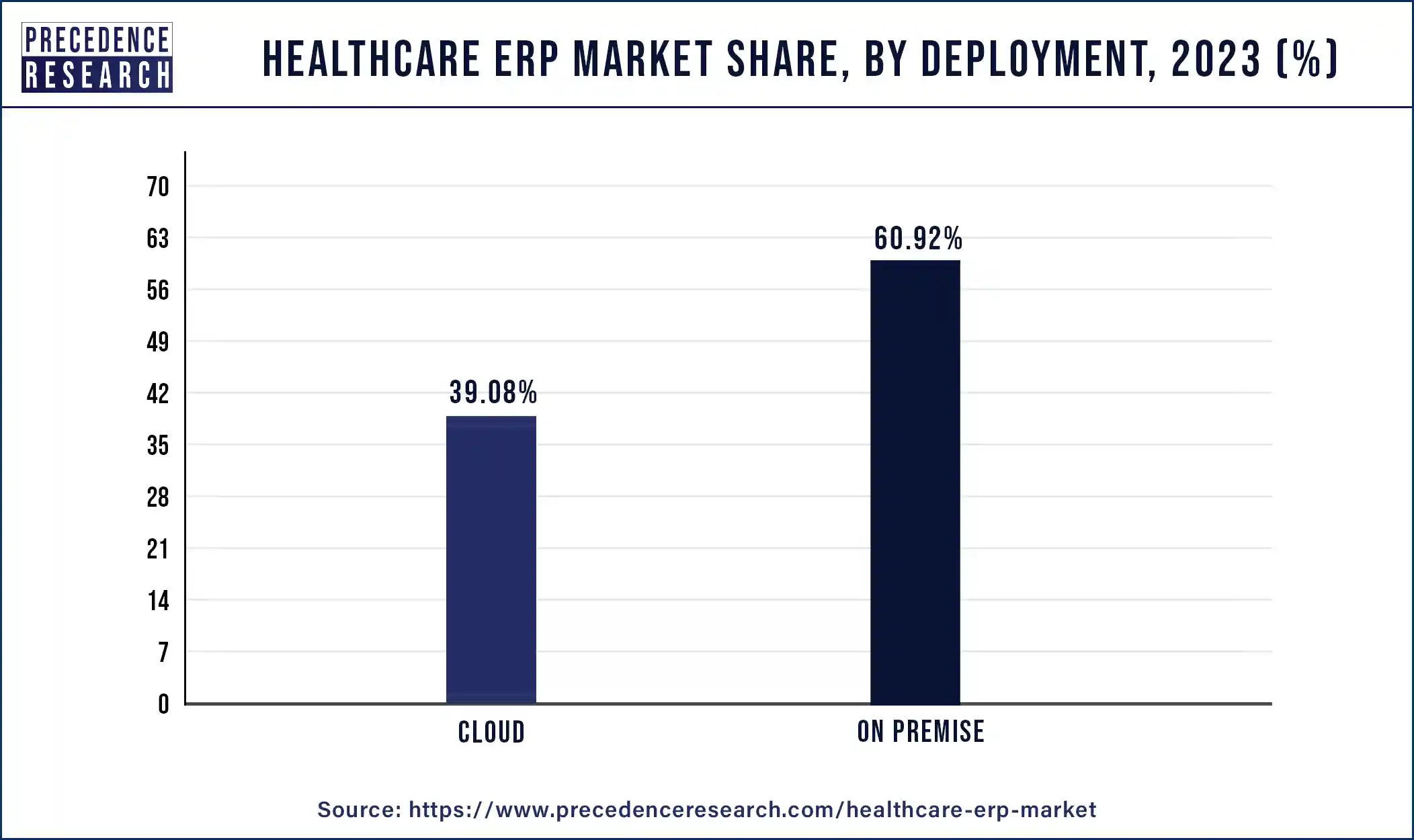January 2025
Healthcare ERP Market (By Function: Supply Chain & Logistics, Finance & Billing, Inventory Management, Patient Relationship Management, and Others; By Deployment: On Premise and Cloud; By End User: Hospitals, Clinics, Nursing Homes, and Others) – Global Market Size, Trend Analysis, Segment Forecast, Regional Outlook 2024-2033
The global healthcare ERP market size was valued at USD 6.28 billion in 2023 and it is projected to hit around USD 12.04 billion by 2033, growing at a CAGR of 6.71% during the forecast period 2024 to 2033.

The U.S. healthcare ERP market size accounted for USD 1.81 billion in 2023 and is estimated to reach around USD 3.19 billion by 2033, growing at a CAGR of 5.84% from 2024 to 2033.

North America dominated the market in 2023 with the largest revenue share 34.08%. This is attributable to the increased adoption of digital and automated technologies in the healthcare sector of North America. Moreover, the increased adoption of healthcare services owing to the increased prevalence of diseases and increased healthcare expenditure has compelled the healthcare service providers to adopt the ERP systems to offer enhanced and personalized services to patients in North America. Moreover, the government initiatives to boost the adoption of digital technologies to reduce the paperwork, maintain a database of the patients, and enhance the delivery of quick health services has played a crucial role in the growth of the North America healthcare ERP market.

On the other hand, Asia Pacific is estimated to be the most opportunistic market during the forecast period. The increasing government investments in the development of digitalized and technologically advanced healthcare infrastructure in the region are expected to drive the market growth. Moreover, the rising prevalence of various chronic diseases and rapidly growing geriatric population is boosting the number of patients at a rapid rate. Therefore, to offer quick and enhanced care services to the patients, the demand for the healthcare ERP is expected to grow rapidly in Asia Pacific region during the forecast period.
The global healthcare ERP market is significantly driven by the rising demand for the efficient digital management solutions in the healthcare sector, growing need for the automation of tasks, and streamlining the information across the departments in the healthcare unit has fostered the adoption of the ERP systems in the healthcare sector. The adoption of the healthcare ERP offers enhanced patient care services and optimum utilization of resources. The developers and the providers are taking efforts to integrate the advanced technologies like Artificial intelligence into the healthcare ERP systems to enhance the efficiency of the system. The AI-powered ERP systems will enhance the data processing and data analytics and would offer more enhanced decision-making.
The various functions offered by the healthcare ERP such as supply chain & logistics, finance & billing, inventory management, patient relationship management helps the healthcare units to focus on the core activities of patient care and treatment and hence foster the operational efficiency of the healthcare units like clinics and hospitals. Moreover, the ERP systems synchronize the patient related data to the clinicians and enhance the patient and healthcare professional interaction.
Furthermore, the growing number of hospital admissions is creating a pressure on the healthcare systems to deliver services quickly. The growing hospital admissions are a result of the rapidly growing prevalence of various chronic diseases among the global population. According to the International Agency for Research on Cancer, in 2020, around 19.3 million new cancer cases and 10 million cancer deaths were reported across the globe. It is estimated that around 28.4 million new cancer cases will be recorded in 2040, globally.
According to the World Health Organization, the cardiovascular diseases results in around 17.9 million or 32% of the global deaths and it is a leading cause of death across the globe. As per the International Diabetes Federation, the global diabetic population is estimated to reach at 783 million by 2045. Therefore, an alarming rise in the number of patients is boosting the number of hospital admissions, which is fostering the deployment of the healthcare ERP systems across the healthcare sector.
| Report Coverage | Details |
| Growth Rate from 2024 to 2033 | CAGR of 6.71% |
| Market Size in 2023 | USD 6.28 Billion |
| Market Size by 2033 | USD 12.04 Billion |
| North America Market Share in 2023 | 34.08% |
| On-premise Segment Market Share in 2023 | 60.92% |
| Base Year | 2023 |
| Forecast Period | 2024 to 2033 |
| Segments Covered | End User, Deployment, Function, Geography |
| Companies Mentioned | Microsoft Corporation, Oracle Corporation, SAP SE, McKesson Corporation, Sage Group Plc., Infor, Inc., Odoo, QAD, Inc., Aptean, Epicor Software Corporation |
The finance and billing segment dominated the market with the highest revenue share in 2023.
The inventory management segment also hit the remarkable share of 19.43% in 2023. The rising number of patients along with the growing consumption of various healthcare products and healthcare consumables across the nursing homes, hospitals, and clinics has significantly boosted the inventory management services of the healthcare ERP. The rising consumption of the healthcare consumables and keeping a track of it to ensure efficient supply of the stocks in the healthcare units has fostered the growth of the inventory management segment.
On the other hand, the patient relationship management is estimated to be the most opportunistic segment during the forecast period. The healthcare ERP helps the healthcare administrators to efficiently handle the backend operations at a low cost thereby enhancing the operational efficiency of the healthcare unit. The ERP systems provides quality patient care and helps to provide personalized healthcare services to the patients, which helps to improve the patient relationship. The enhanced marketing tools and establishment of trust between the doctors and the patients is the significant function of the ERP system that fuels the growth of the patient relationship management segment.
Healthcare ERP Market Value (US$ Mn) Analysis, By Function, 2020 – 2023
| By Function | 2020 | 2021 | 2022 | 2023 |
| Supply Chain & Logistics | 1,267.6 | 1,331.9 | 1,407.8 | 1,493.1 |
| Finance & Billing | 1,785.9 | 1,864.6 | 1,958.3 | 2,063.8 |
| Inventory Management | 998.0 | 1,062.3 | 1,137.3 | 1,221.9 |
| Patient Relationship Management | 736.8 | 765.4 | 799.8 | 838.6 |
| Others | 595.1 | 616.7 | 642.4 | 670.9 |
Based on the deployment, the on-premise segment dominated the market in 2023. This is simply attributable to the increased adoption of the on premise deployment in the past decade across the healthcare sectors.

The cloud segment has captured 39.08% revenue share in 2023 and is estimated to be the fastest-growing segment during the forecast period. The rising adoption of the cloud computing owing to its surging popularity and associated benefits is expected to significantly drive the demand for the cloud computing based healthcare ERP systems across the globe. The cloud computing allows the administrators to remotely store the data on the cloud servers that can be easily accessed through the internet. The rising penetration of internet along with the availability of cheap data is the major factors that boost the growth of this segment.
Healthcare ERP Market Value (US$ Mn) Analysis and Forecast, By Deployment, 2020 – 2023
| By Deployment | 2020 | 2021 | 2022 | 2023 |
| On-premise | 3,370.0 | 3,499.4 | 3,655.2 | 3,831.2 |
| Cloud | 2,013.5 | 2,141.5 | 2,290.3 | 2,457.1 |
The hospitals segment hold significant share of global healthcare ERP market, accounting for 44.18% in 2023. This can be attributed to the increased penetration of the public and private hospitals across the global. The rising investments by the government and the corporate sector in the deployment of digital and technologically advanced tools and equipment are expected to drive the growth of the hospitals. Moreover, the rising number of hospital admission owing to rising prevalence of chronic diseases is fueling the adoption of ERP systems. Furthermore, the rising investments in the development of smart hospitals are another major factor that boosts the growth of the hospital healthcare ERP market across the globe.
On the other hand, the nursing homes segment is estimated to be the most opportunistic market during the forecast period. The rising prevalence of chronic diseases, rising adoption of the convenient services of the nursing homes, and the personalized treatment provided in the nursing homes is fueling the adoption of the nursing home services among the population. The demand for the healthcare ERP among the nursing homes is rising along with the rising number of nursing homes across the developing and the developed markets.
Healthcare ERP Market Value (US$ Mn) Analysis and Forecast, By End User, 2020 – 2023
| By End User | 2020 | 2021 | 2022 | 2023 |
| Hospitals | 2,309.2 | 2,443.6 | 2,601.1 | 2,778.4 |
| Clinics | 1,550.6 | 1,621.9 | 1,706.5 | 1,801.7 |
| Nursing Homes | 983.3 | 1,018.6 | 1,061.3 | 1,109.6 |
| Others | 540.3 | 556.8 | 576.7 | 598.6 |
The global healthcare ERP market is fragmented due to the presence of numerous market players. The market players are constantly engaged in various developmental strategies in order to exploit the prevailing market opportunities and gain competitive advantages. The various developmental strategies such as new launches, joint ventures, acquisitions, and partnerships adopted by the key market players significantly impacts the market growth.
Some of the prominent players in the global healthcare ERP market include:
By Function
By Deployment
By End User
By Geography
For inquiries regarding discounts, bulk purchases, or customization requests, please contact us at sales@precedenceresearch.com
No cookie-cutter, only authentic analysis – take the 1st step to become a Precedence Research client
January 2025
December 2024
February 2025
April 2024